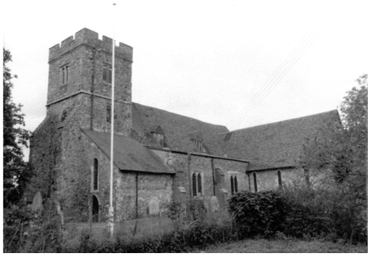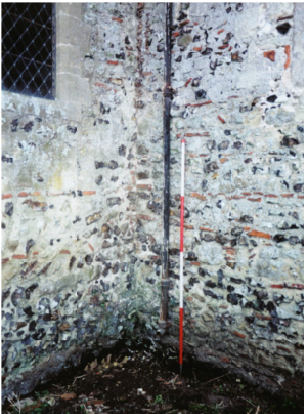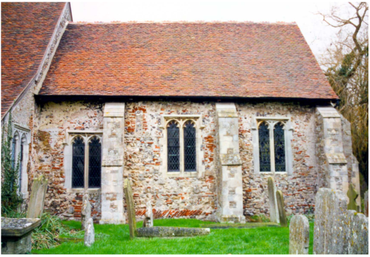Teynham Church History
The Development of St. Mary’s Church, Teynham
Alexander Holton
St Mary’s, Teynham, has long been known as a church of early foundation, being recorded as one of Kent’s pre-Conquest ‘minster’ churches. Although the present building survives as a predominantly 13th to 15th-century structure, recent archaeological investigations have brought to light the existence of fabric much earlier in date. Thus, a re-interpretation of the development of the church can be proposed, which serves to link the current structure and its historical past with greater coherence.
Location and plan form.
St Mary’s church lies approximately 1.2 miles to the north-east of the village of Teynham. The building stands on raised ground on what was formerly the western bank of the River Lynn. Immediately to the south lie the buried remains of the gatehouse and ancillary buildings of the 13th-century Archbishop’s Palace complex, with the palace and its associated buildings themselves located further north-west, adjacent to Teynham Street.
The church is of cruciform plan and consists of a western tower and flanking vestries, followed by the nave, aisles and transepts to the north and south, and the chancel to the east (see Plan I). Much of the exterior dates to the 13th century, but includes both earlier and later building phases. A range of building materials have been used in the construction of the church from a number of periods; these include flint nodules, Reigate stone, Kentish Marble, Caen stone, Kentish Ragstone, pebbles, tufa and, interestingly, Roman brick and tile. This is particularly noteworthy in the east wall of the north transept and its junction with the chancel.
The historical and topographical context
Before discussing the current building, the documentary evidence for the establishment of Teynham church should be considered. Primarily, this comes in the important form of the Domesday Monachorum of Christ Church Canterbury and, in short, shows that a major Anglo-Saxon church was established there. The Domesday Monachorum relates to the diocese of Canterbury in the same way that the Textus Roffensis refers to that of Rochester; both are roughly contemporaneous with Domesday Book and incorporate evidence of ecclesiastical arrangements prior to the Norman Conquest (Everitt 1986, 189). As described by Tatton-Brown (1988, 105), the first folio of Domesday Monachorum contains five statements that deal directly with Kentish churches: (i) a list of 88 churches from each of which a payment (probably mainly for chrism) is made at Easter; (ii) a description of the contributions due from St. Augustine’s Abbey; (iii) a unique list of 12 major churches with lesser ‘daughter’churches in the surrounding area which ‘pertain’ to them; (iv) an account of renders from the first 14 churches in the first list of the payment system prior to Archbishop Lanfranc; and; (v) a list of Romscot payments from East Kent. Essentially, the lists in the Domesday Monachorum are important as they illustrate the framework of the Anglo-Saxon ‘minster’ (or multi-priest) organisation of the diocese, alongside the single-priest system being introduced by Lanfranc in the 1070 to 1080s (Tatton-Brown 1988, 105). Teynham is found in list (iii) as follows:
These churches pertain to TÆNHAM:
DUDDINGTUN (Doddington)
STANE (Stone-by-Faversham)
CILLINGE (Selling)
ÆTWANGERÆDE (Iwade)
Teynham’s ‘control’ over its daughter churches was intertwined with those of its neighbouring minsters, i.e. Milton Regis to the west and Faversham to the east. Additional ‘daughters’ were acquired later on in the form of Lynsted, Newnham, Norton and Buckland. The exact dates of when these churches were established are uncertain, except to say that this was considerably after the Conquest. In time, Lynsted was given, as well as Teynham, Doddington and Iwade, by Archbishop Stephen Langton to his brother, Archdeacon Simon Langton, in 1229 (Selby 1935, 60).
Continuing with the Domesday Monachorum, it is possible to further define the pre-Conquest minster at Teynham. The church also appears in list (iv), or ‘the old institution before the coming of the Lord Lanfranc the archbishop’ (Tatton-Brown 1988, 115). Here, Teynham is shown as contributing ‘1 sester of honey, and 2 sheep and 8 lambs, and 60 loaves, and 12d. for wine and 14d. for oil.’ (Tatton-Brown 1988, 115). As a consequence, it confirms that Teynham was an ‘old’ minster of Anglo-Saxon Kent. In 798 the church at Canterbury recovered an area of land totalling 30 hides that had previously been taken by Offa, King of Mercia (Selby 1935, 2). This holding incorporated Teynham, and therefore it is feasible that by the 9th century the church was founded. In this case, the site was created at the centre of a church estate obtained from the crown, as opposed to that of a later ‘thegn’ or nobleman.
The setting of Teynham church also bears the characteristics proposed by Everitt (1986, 190-194) of an ‘old’ minster: it retained a considerably sizable parish after the four daughter churches were established; it was founded in a former Romano-British community; and, finally, it can be associated with a series of topographical similarities common amongst minster foundations. These similarities are outlined by Everitt (1986, 193). Firstly, they are for the most part prominently established on riverbanks or by major springheads. Secondly, their place-names are invariably ‘primitive’ in character; Teynham is considered to derive from the Anglo-Saxon roots of ‘tynan’ (to enclose), followed by ‘hamm’ (a land drained by dykes) (Selby 1935, 1). Sites such as Dover, Reculver and Lympne may even illustrate a Celtic origin in their names (Everitt 1986, 193). In the third place, when the original boundary of the minster land is reconstructed, it usually resembles a continuous line around its control, represented by the daughter churches.
The current church and previous understanding
With the documentary and topographical evidence in mind, it is appropriate to investigate whether or not any of the Anglo-Saxon church at Teynham has survived. Prior to the archaeological survey undertaken in 2003, little has been published on the building itself. The only exception is a rather convoluted account made by F. C. Elliston-Erwood in 1921. This assessment made no reference to the documentary origin of the church and reached the conclusion that the building had evolved from an early 12th-century structure (Elliston-Erwood 1921, 145, 147) (see Plan II). In theory, this idea was not totally implausible, but no evidence in the fabric could be found to support it. So, from re-inspection, it has been possible to propose an alternative sequence of development.
Phase I: An Anglo-Saxon basilica?
The starting point of this re-assessment is a consideration of the re-use of Roman ceramics in the east wall of the north transept (see Figure 2), which returns into the chancel, since this material underlines the case for an alternative and considerably earlier date for the building. Here, the Roman ceramics are clearly used to level the courses of rougher materials, such as flint and Ragstone. The tegulae (roof tile) pieces that are used are comparable with the more complete examples used in the west wall of Richborough Roman fort (Pearson 2002, 203). Unfortunately, more localised comparisons cannot be drawn at present; although Roman sites exist nearby, their excavations are yet to be published fully.
So, it is fair to say that the re-used material at Teynham is Roman in origin – but what of the arrangement? Figure 3 is a view of the south wall of the chancel of St. Margaret’s, Lower Halstow, which is accepted as being Anglo-Saxon (Tatton-Brown 1988, 110). Newman (2001, 373) is also aware of this, whilst also noting that ‘the tiles mean the usual thing – Saxon’. Aside from the distinct herringboned Roman brick at the base of the wall at Lower Halstow, a close similarity can be followed with Teynham in the manner in which the brick and tile is coursed. As a consequence, the evidence provided would suggest that the portion of the north transept east wall at Teynham bearing these remains is in fact Anglo-Saxon. The difference in size of the re-used material is merely a result of their different source. Eaton (2000, 15) points out how the re-use of Roman material was very much a characteristic of the Anglo-Saxons, and had even petered out in Kent by the late 10th or early 11th centuries, before the Conquest. So, in the 13th century, it would appear that the transepts were not added as Elliston-Erwood suggests, but were extended with their depth to the west increased. At this point it is possible to provide an illustration, given as Plan III, from which the church may have evolved. The solid lines represent points where Anglo-Saxon walling remains, with the remainder assumed; there is, of course, no evidence of these walls, but by observing the characteristics of other Anglo-Saxon churches around Kent and beyond, it is possible to consider a conjectural ‘footprint’ of the early building. As can be seen, what may remain at Teynham is the shadow of an Anglo-Saxon basilica, showing that the church evolved from a very different building to the type claimed by Elliston-Erwood (1921, 145). This alternative plan is formulated on the basis of the following elements – for which there is evidence within the fabric of the present structure:
- The original building consisted of a nave and one, if not two, porticus, the extent of which is preserved by the lower, Anglo-Saxon walling on the east wall of the north transept. The tradition of burial in the transepts, now evident in the later memorial brasses, also substantiates the theory of the presence of porticus elements at Teynham. As stated by Taylor and Taylor (1965, 13) burial within the body of the church was strictly forbidden and to solve this small chambers were provided on either side of the nave, towards the east.
- The nave continued beyond the porticus, suggested by the continuation of the early walling with the re-used Roman material from the east wall of the north transept into the chancel. Herringbone work may also be represented in the north wall of the chancel, while the locality and clear transitions between the early and later builds in the walls also support this idea. The limit of the original nave, rather than a square-ended or apsidal Norman chancel as Elliston-Erwood believed, is therefore represented. To support this idea, plans of Anglo-Saxon churches (for example St. Pancras, Canterbury (Taylor and Taylor 1965, 147)) show that the nave tended to continue beyond the porticus before turning at re-entrant angles to accommodate the chancel space at the eastern end.
An Anglo-Saxon church with porticus, or even transepts, would not be a rarity in the area. Examples to note are St. Mary-de-Castro, Dover, also a minster (Tatton-Brown 1988, 110), Lyminge and, again, St. Pancras, Canterbury (Taylor and Taylor 1965, 14). Significantly, St. Mary-de-Castro and St. Pancras also reflect the exploitation of Roman spolia, while Teynham’s neighboring minster of Milton Regis may have also been of cruciform plan prior to the Conquest (Tatton-Brown 1988, 110).
In respect to the chancel at Teynham, it is not possible to say whether or not it was originally square-ended or apsidal, since both types feature. Furthermore, since the proposed Anglo-Saxon remains at Teynham are not as substantial as those shown at, say, St. Mary-de-Castro, Dover, or St. Pancras, Canterbury, it is not possible to identify the exact relationship between the porticus and the eastern arrangement of the church. To a considerable extent, the variation in church design during the Anglo-Saxon period in Kent, irrespective of function, does not facilitate a conclusion either (Fernie, 1983, 40). For instance, the minster church of St. Mary, Reculver illustrates a further difference in the use of the porticus (Taylor and Taylor 1965, 506). Here, the cells are arranged in respect to the apse from where they are exclusively accessed. This is also the case at St. Mary’s, Canterbury, and St. Peter-on-the-Wall, Bradwell-on-Sea, Essex (Taylor and Taylor 1965, 91, 145). However, it may be possible to associate the plan at Teynham, postulated in Plan III, with the ‘Braemore’ type of crossing. This type can be traced back to the early period, through Winchester, Brixworth and Deerhurst (Fernie 1983, 112).
Finally, the possible western arrangement of Plan III should be dealt with. The present west tower may or may not represent the position of an earlier tower or porch; only its position, rather than any architecture, can propose this, although it is interesting that the tower was not located over the crossing, as is the case with Folkestone (St. Mary and St. Eanswith, 12/13th century), Minster-in-Thanet (St. Mary, rebuilt 12th century) and Northbourne (St. Augustine, Norman) (Newman 2001, 323, 393-4, 406). Tatton-Brown (1988, 110) groups these minster churches with Teynham, along with Eastry (St. Mary), Faversham (St. Mary) and Wingham (St. Mary), on the basis that they are all structures that have evolved from a 12th century core, and almost all are cruciform in plan and dedicated to St. Mary. Without investigating their supposed 12th century origins in detail, their plans (where Eastry and Wingham also have western towers) and dedications remain the only similarities between these churches and Teynham. In other respects, Teynham and Faversham appear separate from this grouping, especially in terms of building materials. Flint and Caen stone are noted by Newman (2001) as the provincial materials used at the main group of churches, which contrast to the Roman re-use at Teynham, along with the mixture of materials including Ragstone. Heavy restoration at Faversham has left only remnants of Ragstone on the exterior (Newman 2001, 314).
In terms of the common dedication, this can be accounted for by its popularity in Kent
in general; both St. Mary and St. Ann were regularly connected with holy wells and fertility customs (Everitt 1986, 232). Furthermore, Tatton-Brown’s construction of this grouping with the common dedication as one of the contributing factors does not allow for the complications that are highlighted by Everitt (1986, 233). The relationship between the dedication of a church and the period of its foundation is not always simple – some of the commonest, such as St. Mary and St. Peter and St. Paul, can occur in any period from the 7th century onwards. With the exception of the use of the definite post-Conquest saints, and those from France (for example St. Leonard), it is not generally possible to discern between common pre and post-Conquest dedications.
Phase II: the 13th century
It is feasible to suggest that, from the evidence, a predominantly 13th century phase evolved from the Anglo-Saxon church at Teynham (see Plans I and III) Here, the aisles and chancel were added and the tower built (or rebuilt over an earlier porch or tower) and the transepts expanded. In the case of the tower, a blocked lancet on the west wall of the ringing stage implies a date of the 13th century for the first two storeys. In relation to the north aisle, the present material could have been re-absorbed from the pierced nave, now supported by western buttresses (now found internally in the vestries). To the east, the Anglo-Saxon nave wall linking to the porticus became the basis of the new chancel, resulting in its thickening on the inside in collaboration with the new chancel wall. The transepts were enlarged to the west to accommodate a larger altar space, and to the north and south to allow the inclusion of two altars in each. This is unusual in a parish church at this time, where the altars were probably required for use by priests associated with the Archbishop’s Palace. Overall, it would seem that the Anglo-Saxon Church was practically rebuilt during this period, perhaps in tandem with the development of the Archbishop’s buildings.
Phase III: the 15th century
The 15th century marks the final main developments of the church in the form of re-modelling, as opposed to a drastic alteration of the plan. The tower was raised, marked by the change in fabric above the stringcourse from flint to Ragstone, while windows and a crenellated parapet were also added. The 13th-century aisles were rebuilt to the south and restored to the north, suggested by the fact that the windows do not appear to interrupt any earlier fenestration scheme. Furthermore, during restoration of the south aisle interior in 2000, it was possible to inspect the nature of construction beneath the render. This revealed that the string course from the south transept was interrupted by a straight joint at its junction with the aisle, proving that this part of the church was not of the 13th century but was composed of a 15th-century rebuild. Later on in the 15th century, the aisles were also raised several courses to comply with changes to the interior. In terms of the interior as a whole, 15th century modifications and re-modelling prevail, with only a few reminders of the 13th century build. Of the 13th-century phase, only the lancet window spaces, the piscina in the south wall of the chancel, the remains of the stringcourses and the aisle archways to the transepts remain. Generally, the nave, transepts and aisles reflect the 15th century work, particularly in terms of the arcades, columns and crown-post roofing, which have completely replaced any earlier architecture. In the case of the transepts, they retained their 13th-century lancets in all but their eastern walls. Here, the lancets were dismantled to accept larger, 15th-century Perpendicular windows. These acted as more conspicuous ‘east windows’ for the chantry altars that had been established in the transepts. A large Perpendicular window was also inserted into the east wall of the chancel. Finally, the flanking vestries to the north and south of the tower can also be assigned to the 15th century as they were originally continuations of the rebuilt aisles. In the 19th century, it appears that they were modified to create separate rooms. This involved the reduction in height of the vestry walls, the alteration in the pitch of the roofs the construction of the internal partition walls and the replacement of the external entrances.
Conclusion
In sum, this article has offered a re-interpretation of St. Mary’s church, Teynham, and has suggested that the present building can be tied to its historical foundation with greater precision than was once previously thought. It is entirely feasible that work of the Anglo-Saxon period has been retained within the north transept, and this has enabled a tentative sequence of development to be postulated. It is possible that the church evolved from its foundation as a minster in the form of a basilica, consisting of a nave, chancel, and one, if not two, porticus. Into the 13th century, the church was substantially rebuilt and enlarged where the aisles and tower were added alongside the extension of the chancel and transepts. By the mid-15th century, the interior was refurbished, windows were replaced, the aisles were rebuilt and the tower was raised. Further restoration work to the interior may reveal additional answers to the history and development of this important parish church; moreover, the nature of the site before the minster and the source of its re-used building material still warrants investigation.
Figures

Figure 1: St. Mary’s church, Teynham, from the south west (Photograph: the author)

Figure 2: Re-used Roman ceramics in the east wall of the north transept (right) and its junction with the chancel (left). (Photograph: the author)

Figure 3: St. Margaret’s church, Lower Halstow. South wall of chancel bearing
Anglo-Saxon re-use of Roman ceramics. (Photograph: the author
Select Bibliography
Adam, J P (1994). Roman Building Materials and Techniques. London: Batsford.
Blair, J, and Sharpe, R (eds.) (1992). Pastoral Care Before the Parish. Leicester:
Leicester University Press.
Cunnington, P (2001 edition). How Old is That Church? Yeovil: Marston House.
Eaton, T (2000). Plundering the Past: Roman Stonework in Medieval Britain.
Gloucestershire: Tempus.
Elliston-Erwood, F C (1921). ‘Teynham Church: Architectural Notes’, Archaeologia
Cantiana 35, 145-159.
Everitt, A (1986). Continuity and Colonisation: The Evolution of Kentish Settlement.
Leicester: Leicester University Press.
Fernie, E (1983). The Architecture of the Anglo-Saxons. London: Batsford.
Holton, A (2003) A Re-evaluation of St. Mary’s Church, Teynham, Kent. Unpublished BA Thesis, available for consultation at Canterbury Cathedral Archives.
Jessiman, I McD (1957-58). ‘The Piscina in the English Medieval Church’, Journal of the British Archaeological Association 20-21, 53-7.
Morris, R (1989). Churches in the Landscape. London: J. M. Dent and Sons.
Newman, J (2001 edition). The Buildings of England: North East and East Kent.
Harmondsworth: Penguin.
Parsons, D (ed) (1990). Stone Quarrying and Building in England AD43-1525.
Chichester.
Pearson, A (2002). ‘Stone Supply to the Saxon Shore Forts at Reculver, Richborough,
Dover and Lympne’, Archaeologia Cantiana 122, 197-220.
Richmond, H (2003). St. Mary’s, Teynham: Diocesan Advisory Committee Report 2003. Unpublished survey available for consultation from the DAC Office, Canterbury Cathedral Precincts.
Selby, E (1935). Teynham Manor and Hundred. Rainham: Meresborough Books.
(Reprinted in 1982 with additional illustrations).
Tatton-Brown, T (1988). ‘The Churches of Canterbury Diocese in the 11th Century’ in Blair, J (ed.), Minsters and Parish Churches: The Local Church in Transition 950-1200. Oxford University Committee for Archaeology Monograph No. 17, 105-118.
Tatton-Brown, T (2001). ‘The Quarrying and Distribution of Reigate Stone in the Middle Ages’, Mediaeval Archaeology 45, 189-201.
Taylor, H M, and Taylor, J (1965). Anglo Saxon Architecture (Vols. I-III). Cambridge: Cambridge University Press.
Warssam, B C, and Tatton-Brown, T (1993). ‘Kentish Rag and other Kent Building
Stone’, Archaeologia Cantiana 112, 93-125.



